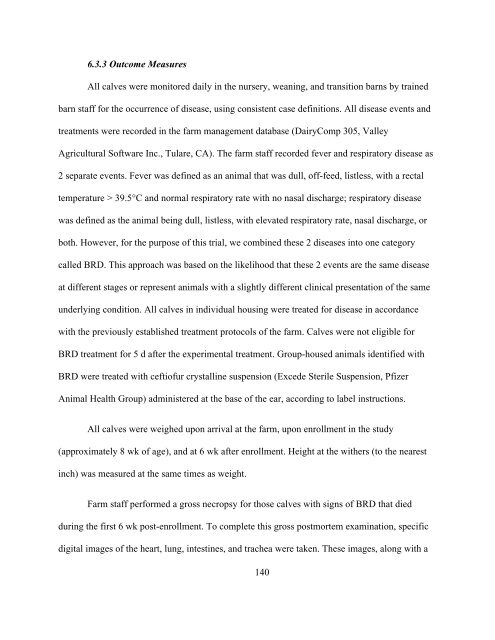Stanton PhD Thesis final_docx - Atrium - University of Guelph
Stanton PhD Thesis final_docx - Atrium - University of Guelph
Stanton PhD Thesis final_docx - Atrium - University of Guelph
Create successful ePaper yourself
Turn your PDF publications into a flip-book with our unique Google optimized e-Paper software.
6.3.3 Outcome Measures<br />
All calves were monitored daily in the nursery, weaning, and transition barns by trained<br />
barn staff for the occurrence <strong>of</strong> disease, using consistent case definitions. All disease events and<br />
treatments were recorded in the farm management database (DairyComp 305, Valley<br />
Agricultural S<strong>of</strong>tware Inc., Tulare, CA). The farm staff recorded fever and respiratory disease as<br />
2 separate events. Fever was defined as an animal that was dull, <strong>of</strong>f-feed, listless, with a rectal<br />
temperature > 39.5°C and normal respiratory rate with no nasal discharge; respiratory disease<br />
was defined as the animal being dull, listless, with elevated respiratory rate, nasal discharge, or<br />
both. However, for the purpose <strong>of</strong> this trial, we combined these 2 diseases into one category<br />
called BRD. This approach was based on the likelihood that these 2 events are the same disease<br />
at different stages or represent animals with a slightly different clinical presentation <strong>of</strong> the same<br />
underlying condition. All calves in individual housing were treated for disease in accordance<br />
with the previously established treatment protocols <strong>of</strong> the farm. Calves were not eligible for<br />
BRD treatment for 5 d after the experimental treatment. Group-housed animals identified with<br />
BRD were treated with cefti<strong>of</strong>ur crystalline suspension (Excede Sterile Suspension, Pfizer<br />
Animal Health Group) administered at the base <strong>of</strong> the ear, according to label instructions.<br />
All calves were weighed upon arrival at the farm, upon enrollment in the study<br />
(approximately 8 wk <strong>of</strong> age), and at 6 wk after enrollment. Height at the withers (to the nearest<br />
inch) was measured at the same times as weight.<br />
Farm staff performed a gross necropsy for those calves with signs <strong>of</strong> BRD that died<br />
during the first 6 wk post-enrollment. To complete this gross postmortem examination, specific<br />
digital images <strong>of</strong> the heart, lung, intestines, and trachea were taken. These images, along with a<br />
140

















